Hasta Vinyasas
Hasta Vinyasas (Sanskrit: हास्त विन्यास; Sanskrit pronunciation: [ɦɐːstɐ ʋin̺jɐːs̺a]; IAST:Hāsta Vinyāsa) are a set of yoga vinyāsas which primarily involve movement of the arms.[1]
The Hasta Vinyasas are: Pārśvabhāga (Lateral Side Movement), Pūrvabhāga (Frontal Stretch), Prasarana (Sweeping Movement), Elbow Movement, Hands on Shoulder Blades Movements, Hands-Lock Behind Movements, Prishtanjali (Back Salute), and Shoulder Rotations.[2]
Etymology
Hāsta Vinyāsa is Sanskrit; Hāsta Sanskrit: हास्त and adjective meaning "formed with the hands",[3] and Vinyāsa Sanskrit: विन्यास meaning "movement".[4]
Below is a table describing of the etymology behind each of the Hāsta Vinyāsas. All non-English words in this table are Sanskrit.
| English Translation | IAST | IPA | Devanagari | Literal Meaning |
|---|---|---|---|---|
| Lateral Side Movement | Pārśvabhāga Vinyāsa | Sanskrit pronunciation: [pɐːɹɕʋɐbʰɐːɡɐ ʋin̺jɐːs̺a] | पार्श्वभाग विन्यास | Pārśvabhāga:side-portion[5] |
| Frontal Stretch | Pūrvabhāga Vinyāsa | Sanskrit pronunciation: [puːɹʋɐbʰɐːɡɐ ʋin̺jɐːs̺a] | पूर्वभाग विन्यास | Pūrvabhāga: front part[6] |
| Sweeping Movement | Prasaraṇa Vinyāsa | Sanskrit pronunciation: [pɹɐs̺ɐɹɐɳˌɐ ʋin̺jɐːs̺a] | प्रसरण विन्यास | Prasaraṇa: spreading forth (or Prasāraṇa: Broadcast)[7] |
| Elbow Movement | – | – | – | – |
| Hands on Shoulder Blades Movements | – | – | – | – |
| Hands Lock Behind Body Movements | – | – | – | – |
| Reverse Prayer[8] or Back Salute[9] Movement | Paścima Namaskāra Vinyāsa or Pṛṣṭa Añjali | IPA: [pɐɕtɕ͡iːmɐ nɐmɐskɐːɹɐːsɐnɐː] or IPA: [pɻʂʈʰɐ ɐñɟʝ͡ɐl̺i] | पश्चिम नमस्कारा or पृष्ट आञ्जलि | See Etymology for Reverse Prayer Pose or Pṛṣṭha: back;[10] Añjali: "joining palms of the hands" or "salutation"[11][9] |
| Shoulder Rotations | – | – | – | – |
Description

As vinyasas which have Tadasana as their base, the Hasta Vinyasas improve balance, and calm the mind (which also helps to produce a steady body) and ready a practitioner for āsana practice.[12] Simultaneously the movement of the Hasta Vinyasas help invigorate the body and prepare it for other āsana practice. [13]
When performing these vinyasas, all bandhas may be engaged, except in the backward bending vinyasas, where Jalandhara Bandha is not fully engaged.[1]
Additionally, pranayama is of utmost importance during vinyāsa practice. Breath and movement should be coordinated appropriately.[1]
Pārśvabhāga Vinyāsa

The starting position for Pārśvabhāga Vinyāsa is Samasthitiḥ. While inhaling, stretch the arms straight to the sides and over the head, ending the inhale with the fingers interlaced and palms facing upward (this position is called Urdhva Baddhanguliyasana). As the palms are being turned out, the arms should be pulled upwards. After remaining in the stretch with the arms above the head for a moment, with the exhale, the hands are then brought out along sides back to Samasthitiḥ. The length of the upwards and downwards actions (and thus both inhale and exhale) should be equal, and long (perhaps, 5 seconds). It can be practiced a few times stretching more each time. Pārśvabhāga Vinyāsa primarily stretches the sides and the chest muscles.[14] This movement provides a healthy stretch to thoracic cavity and rib structures, especially with a slight back bend.[15]
Pūrvabhāga Vinyāsa
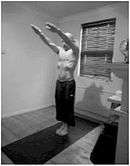

Like Pūrvabhāga Vinyāsa begins in Samasthitiḥ, but the hands are turned so the palms face backwards. As in Pārśvabhāga Vinyāsa, the arms are raised slow with the inhale. At the peak, the palms face forward. The breath may be held for a moment, before lowering the arms with the exhale; both breath and movement finishing simultaneously. This vinyāsa can be performed a few times, progressively deepening the stretch. [14]
Prasaraṇa Vinyāsa
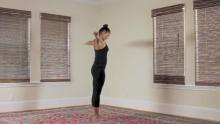
From a standing position (as in Samasthitiḥ) with the arms crossed palms on opposite thighs, swing the arms slowly out and up to shoulder height on their respective sides, hold for a moment, and return the hands. The movement, as with Pārśvabhāga Vinyāsa and Pūrvabhāga Vinyāsa, is done inhaling up, and exhaling down, the motions beginning and ending with their appropriate breath. It can also be repeated a few times. Prasaraṇa Vinyasa is a good chest opener, especially when breathing deeply.[13]
Elbow Movement
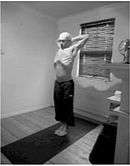

The Elbow Movement involves interlocking the fingers behind the base of the head (at the neck), with the arms raised and out to the sides. From standing (Samasthitiḥ) the arms are first raised above the head on the inhale, and then lowered on the exhale (fingers interlocked) to their place behind the head, with the chest open and shoulder blades adducted (moved towards the center; together). There is then a pause, and the hands are raised again while inhaling, and returned slowly to the sides with the exhale. This position should not be forced if the practitioner exhibits stiffness. [13] The elbow movement can be repeated a few times before returning the hands to the sides, but always with the breath. Especially with a slight back bend, this position expands the thoracic cavity increasing lung capacity as well as stretching the intercostal muscles.[16]
Hands on Shoulder Blades Movements


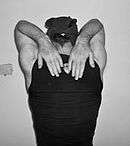
There are two main "Hands on Shoulder Blades" hand positions. One with the hands on their respective shoulderblades, and the other with the hands on their opposite shoulder blades. Both positions are entered in the same way. From Samasthitiḥ, on the inhale, the hands are raised over the head, as in Pārśvabhāga Vinyāsa, and with the exhale the elbows are bend and the hands are brought behind the back (to their appropriate position). The position is held for between three and six full breaths (where one breath equals one inhale, and one exhale). To return to Samasthitiḥ, the arms are again raised on an inhale, and returned as in Pārśvabhāga Vinyāsa to the sides. Both movements open the chest, notably the pectoral muscles, and above the clavicles, and top area of the lungs.[17]
Hands Lock Behind Body Movements


These are two different positions: One with the hands interlaced palms down behind the body, and the other with the hands at the elbows behind the body. They can both be practiced with minor back bends. Both are entered in the same way (as with other Hasta Vinyasas): From Samasthitiḥ, raise the hands on an inhale as in Pārśvabhāga Vinyāsa, and lower with the exhale to the appropriate hand position. When exiting these positions, the hands are simply returned to the sides (to Samasthitiḥ) and not brought back up above the head.[9]
Hands at Elbows Behind the Body
One hand clasps the elbow from the inside (palm on the side of the elbow which is toward the body), and the other under the opposite bent elbow. When practiced as an Hasta Vinyasa, a minor back-bend can be performed starting on an inhale after entering the pose. When back-bending, the chest is lifted, shoulders dropped, and shoulder blades brought inward. There is then a pause with the breath held for a moment, and on the exhale one returns to standing (or Sanskrit: sthitiḥ). This back bending series is repeated 3–6 times. This hand position can also be applied to other asanas, such as uttanasana, as well as backward bending poses. [9]
Hands Interlaced Palms Down
In the position the fingers are interlaced with the palms facing downward, arms behind the back. A back bend is initiated on the inhale, with care taken to lift the chest up, and bring the shoulders down (adducting the scapula). The posture is held for three to six breaths before returning with an exhale to a standing position. This position stretches the chest, and facilitates back-bending.[9]
Reverse Prayer Vinyasa

When performing Paścima Namaskāra Vinyāsa (Reverse Prayer Vinyasa) or Pṛṣṭa Añjali (Back Salute) the arms are raised on an inhale, as in Pārśvabhāga Vinyāsa,. On the exhale, they are brought, palms together to the bottom of the spine and slid upwards. All other aspects of the hand and arm position correspond with Paścima Namaskārāsana (Reverse Prayer Pose). A back-bend can be added on the inhale in a similar fashion as with Hands at Elbows Behind the Body (on the inhale, repeated three to six times). After all, placing the hands on the elbows is considered a modification of Paścima Namaskārāsana.[9]
Shoulder Rotation Vinyasas
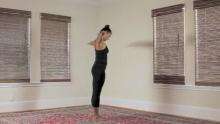
There are two Hasta Vinyāsas for shoulder rotation: One is a back bend with hands over the head, followed by a simultaneous return to standing, and movement of the arms toward the front. The other is an arm movement lowering the arms and from above the head, and then opening horizontally to the sides.[18]
Back Bending Shoulder Rotation
Beginning with the fingers interlaced (palms out) above the head (as at the apex of Pārśvabhāga Vinyāsa), a back-bend is performed on the inhale. On the following exhale, the arms are brought around the sides to the front in an arc, ending palms up in front of the body.[18]
Upright Shoulder Rotation
With the hands beginning above the head, palms facing forward, roughly shoulder width apart (as at the apex of Pūrvabhāga Vinyāsa), the arms are lowered on an exhale to shoulder level (ending with the palms down).[18]
Style of Yoga
The Hasta Vinyasas originate from Vinyasa Krama Yoga.[13]
References
- 1 2 3 Ramaswami 2005, p. 4.
- ↑ Ramaswami 2005, p. 4-10.
- ↑ "SpokenSanskrit.de: हास्त Entry". Retrieved 2012-04-07.
- ↑ "SpokenSanskrit.de: विन्यास Entry". Retrieved 2012-04-07.
- ↑ "SpokenSanskrit.de: पार्श्वभाग Entry". Retrieved 2012-04-03.
- ↑ "SpokenSanskrit.de: पूर्वभाग". Retrieved 2012-04-03.
- ↑ "SpoekSanskrit.de:". Retrieved 2012-04-07.
- ↑ Fitz-Simon 2010.
- 1 2 3 4 5 6 Ramaswami 2005, p. 8.
- ↑ "SpokenSanskrit.de: पृष्ट Entry". Retrieved 2012-04-11.
- ↑ "SpokenSanskrit.de: आञ्जलि Entry". Retrieved 2012-04-11.
- ↑ Ramaswami 2005, p. 1.
- 1 2 3 4 Ramaswami 2005, p. 6.
- 1 2 Ramaswami 2005, p. 5.
- ↑ Kaminoff 2007, p. 25-26.
- ↑ Coulter 2001, p. 102.
- ↑ Ramaswami 2005, p. 7.
- 1 2 3 Ramaswami 2005, p. 9.
External links
Sources
- Ramaswami, Srivatsa (2005). The Complete Book of Vinyasa Yoga. Da Capo Press. ISBN 978-1-56924-402-9.
- Kaminoff, Leslie (2007). Yoga Anatomy. The Breath Trust. ISBN 978-0-7360-6278-7.
- Coulter, H. David (2001). Anatomy of Hatha Yoga. Body and Breath Inc. ISBN 978-0-9707006-0-5.
- Fitz-Simon, Witold (2010). "Arm Variations: Pashchima Namaskarasana". Yoga Art and Science. Retrieved 2012-04-02.